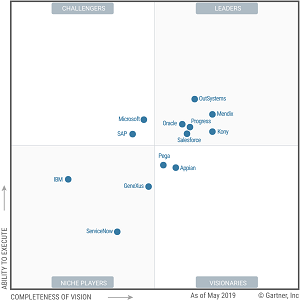News
Low-Code Specialists Dominate 'Multiexperience Development Platform' Ranking
- By David Ramel
- July 16, 2019
With the infiltration of new technologies in the mobile app development space, Gartner Inc. has renamed its former mobile-centric series of research reports to "multiexperience," and the first such offering shows familiar low-code vendors leading the pack.
Those new technologies affecting mobile development include augmented reality (AR), virtual reality (VR), artificial intelligence (AI) and more. The resultant multiexperience apps included in Gartner's research are mobile apps, conversational apps (voice assistants and chatbots), Progressive Web Apps (PWAs), immersive apps, wearable apps and so on.
In its first-ever "Magic Quadrant for Multiexperience Development Platforms" report, published July 10, Gartner said:
The term "multiexperience" refers to the various permutations of modality (touch, voice and gesture, for example), device and app with which users interact on their digital journeys across diverse touchpoints. Multiexperience development involves creating fit-for-purpose apps based on touchpoint-specific modalities, while at the same time ensuring a consistent user experience across web, mobile, wearables, conversational and immersive touchpoints. Multiexperience development is typically undertaken using a variety of technologies (see "Survey Analysis: Insights to Kick-Start an Enterprise Multiexperience Development Strategy"), but single platforms are emerging that bring together the required technologies.
In the report (licensed for distribution by several featured vendors), familiar low-code specialists take center stage, with the breakdown (not in any strict order) being:
- Leaders:
- OutSystems
- Mendix
- Kony
- Progress
- Salesforce
- Oracle
- Visionaries:
- Challengers:
- Niche Players:
The familiar Magic Quadrant graphic shows how those vendors line up on the "ability to execute" and "completeness of vision" axes:
 [Click on image for larger view.]
Multiexperience Development Platforms (source: Gartner)
[Click on image for larger view.]
Multiexperience Development Platforms (source: Gartner)
Although "mobile" has been replaced with "multiexperience," Gartner said custom mobile app development will continue to be the main driver of MXDPs in the next two years, with PWAs also an important criterion.
The research firm also noted the low-code influence, noting that although an MXDP may be used to support "citizen developers," such developers aren't the main users of MXDPs. "All MXDPs support the need of professional developers to use high-control development tools (in [other] words, code-centric tools), and most also support development using low-code approaches for higher developer productivity," the report said. "However, the primary purpose of these platforms is not to support low-code development, but rather the creation of multiple types of app in support of the digital user experience across devices and interaction modalities."
However, low-code development was an evaluation criterion, and among the vendors studied in the report, Appian, GeneXus, IBM, Kony, Mendix, Oracle, OutSystems, Pega, Progress, Salesforce, SAP and ServiceNow (in other words, 12 of the 13 featured firms) all received attention for their low-code tools, leaving only Microsoft out in the low-code cold. In fact, going back to at least April 2017, OutSystem, Mendix and Salesforce have appeared as "Leaders" in Gartner's low-code reports, with that particular report also including Kony, Appian and ServiceNow.
Regarding the overall market, the report said: "Gartner expects more competitors to enter the MXDP market over the next two years, particularly large application PaaS vendors that already target development teams. Acquisitions of smaller best-of-breed mobile, conversational or immersive development vendors could also propel the acquirers into the MXDP market. We expect the market's expansion to accelerate as the underlying technologies for PWAs, conversational and immersive apps mature over the next two to five years."
Other findings in the report include:
- Gartner expects conversational app development to become more prominent as advances are made in tooling and user experience
- Voice apps will primarily be tied to Amazon Alexa and Google Home platforms
- In the immersive development space, AR use case on iOS and Android are expected to be the primary MXDP focus
- Support for VR and specialized hardware for immersive use cases will be specific to platforms for certain industry solutions
- Wearable apps will primarily target smartwatches over the next two years
In advice for its enterprise customers, Gartner said: "A MXDP should serve as a technological cornerstone of your application development strategy for many years to come. It will be a major influence in terms of shaping your development practices and team skills around its capabilities. Some companies may already be using more than one of the vendors in this Magic Quadrant for app development. Determine whether one of the featured vendors' platforms stands out as the best choice for your primary MXDP."
The research firm offered several recommendations for doing just that.
About the Author
David Ramel is an editor and writer for Converge360.